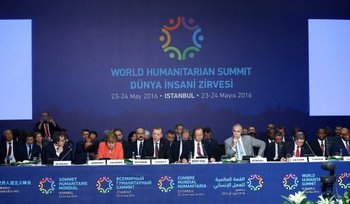Alice Obrecht is writing this blog in a personal capacity.
Ask the CEO of a company if they would rather have bad performance data for their firm or no data at all and they are likely to go for the first option. Having no data at all reflects an absence of the systems needed to tell you how your organisation is performing. While bad performance data isn’t great news, it at least gives decision-makers the ability to learn, understand, and make sound decisions for improvement.
This is important for understanding the current data challenges facing the humanitarian aid sector. We only need to glance at the morning’s headlines to guess that crises, and the situation for people affected by them, are not getting much better:
- A total of 201 million people were in need of humanitarian assistance in 2017, the highest number than ever before, with 68.5 million people displaced by the end of 2017 – IDMC's recent report on global internal displacement indicates that this figure is likely to rise again once all figures on internal and cross-border displacement are collated for 2018.
- The number of children killed or maimed in war has gone up, as well as the number of local aid workers and health care professionals, who have increasingly become targets for attack in violation of International Humanitarian Law and UN Security Council Resolution 2286.
- Harrowing stories from last year’s report by the U.N.'s Commission on Human Rights on sexual torture and rape in South Sudan as well as thousands of accounts from Rohingya women and girls are reminders that gender-based violence is still a common experience for many worldwide.
- The failure to address women and girls’ menstrual hygiene needs in crisis response continues to put them at higher risk for other dangers, such as contracting cholera in the current response to Cyclone Idai in Mozambique.
While there are many great, independent organisations working to provide figures like the ones I’ve just mentioned above, the problem is that little of this data is tied to any collective process for monitoring progress and making improvements. Three years ago, in May 2016, there was an opportunity to generate more collective momentum for change at the first-ever World Humanitarian Summit in Istanbul, Turkey.

Photo credit: Flickr/World Humanitarian Summit
The Summit featured elaborate stagecraft, with children escorting then-Secretary General Ban Ki Moon to the stage and high-level roundtables with heads of state. Attendees from 185 organisations and governments made over 3,000 commitments at the Summit to prevent and end conflict and to make humanitarian aid more inclusive, effective and efficient.
The energy at the Summit has not been matched by efforts to collectively understand progress on the commitments made by agencies and governments since.
While there is annual reporting on progress in achieving the Agenda for Humanity, the self-reporting from stakeholders is highly varied in quality and tends to focus on activities being implemented, rather than on data that can tell us whether these activities are having a real impact. If we look to similar frameworks in the development sector, there are clear differences in how data and progress monitoring are being approached. While the trajectory for progress on the Sustainable Development Goals does not seem bright at the moment, clear targets exist and there is active work underway to fund and address data gaps, in order to help governments meet the SDGs and hold them accountable for doing so.
For some of the problems addressed by the Summit, commitments have been replaced by more substantive international frameworks, most notably the Global Compact for Safe, Orderly and Regular Migration and the Global Compact for Refugees – and the use of data for tracking progress on these promises to be much stronger. But there are several issues addressed by the Summit – such as internal forced displacement, respect for International Humanitarian Law, conflict prevention and addressing the specific needs of women and girls in crisis – which have not been followed up with strong collective implementation and monitoring. A feasibility study led by ALNAP to assess data availability for tracking progress against the Summit commitments found only 5% of indicators would have sufficient data at a global level if baselines were taken in 2017.
Given the amount of time and resource that was funnelled into the World Humanitarian Summit and the importance of the challenges it tried to address, it is worth asking if we can do better to understand whether any progress is being made and, if not, how to course correct. Only then can we start to see greater accountability for commitments made on a global stage and become deserving of such grand stagecraft.